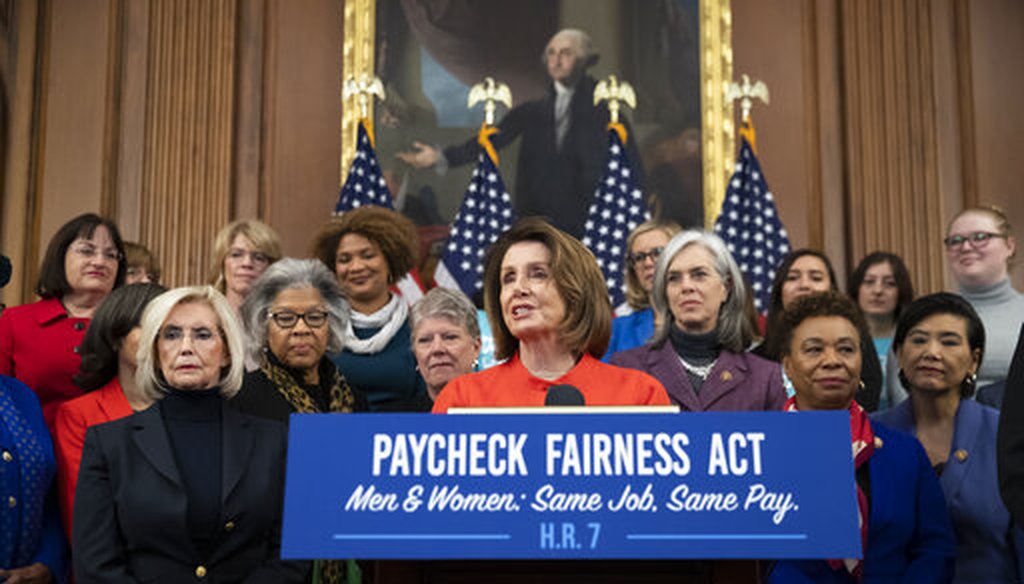Get PolitiFact in your inbox.

Speaker of the House Nancy Pelosi, D-Calif., joined at left by Lilly Ledbetter, an activist for workplace equality, speaks at an event to advocate for the Paycheck Fairness Act, Jan. 30, 2019. (AP Photo/J. Scott Applewhite)
The disparity in how much women make compared with men comes up often in the political discourse, tagged with a call to action to help women’s paychecks catch up.
Several leading Democratic presidential candidates recently highlighted one of the biggest imbalances — saying that a Latina woman must work 23 months to make the amount a white man makes in one year, or that they make 54 cents on the dollar.
PolitiFact has been fact-checking claims about women’s pay for years. It’s important to know a speaker’s choice of words can significantly affect whether their point about the gender pay gap is right or wrong.
Women on average do make less than men, but the government data isn’t based on men and women doing the same jobs. It’s an average that widens or closes by factors such as race, type of job, and age. Research suggests women are overrepresented in jobs that tend to pay less, for a variety of reasons.
Here’s a fresh look at the numbers, factors attributed to the gender pay disparity, and new legislation seeking to eliminate the pay gap.
Women get paid less, but there’s more to know
The median earnings for men and women who worked full-time, year-round were $55,291 and $45,097, respectively, according to 2018 Census Bureau data. In other words, women made 81.6 cents on the dollar compared to men. That was not statistically different from 2017, when women made 80.5 cents on the dollar.
Know this about the data: it is not a direct comparison of men and women doing the same work.
It compares all women’s earnings with all men’s earnings. The figure also does not adjust for other factors, such as degrees and jobs women pursue, the time they take off to care for children, the number of hours they work, and years of work experience. So while the data does show a disparity, it is not an apples-to-apples comparison of pay for equal work.
Other data commonly used to measure the gender pay disparity comes from the Bureau of Labor Statistics, particularly its reports on usual weekly earnings of wage and salary workers. (BLS gets its data from the Census Bureau’s monthly Current Population Survey sent to about 60,000 households nationwide.)
In the third quarter of 2019, women’s median weekly earnings were $825, or 82.3% of the $1,002 median for men, BLS reported.
The earnings ratio varied by race and ethnicity. Here’s a breakdown of that third quarter data:
• White women earned 82.2% as much as white men
• Asian women earned 83.7% as much as Asian men
• Hispanic women earned 87.3% as much as Hispanic men
• Black women earned 88.9% as much as black men
Median weekly earnings of blacks and Hispanics working full-time were lower than those of Whites and Asians, BLS said.
(Here’s detailed government data on earnings from 1960 through 2017.)
Pew Research Center analyzed data on the median hourly earnings of both full- and part-time workers and found that in 2018, women earned 85% of what men earned.
Beyond the numbers: What’s driving the disparity?
We often hear that discriminatory practices are a reason why on average women are paid less than men. Expert say it’s hard to measure how much of a role that discrimination plays in the disparity.
"Research shows that more than half of the gap is due to job and industry segregation — essentially, women tend to work in jobs done primarily by other women, and men tend to work in jobs done primarily by other men and the ‘men’s jobs’ are paid more," said Jennifer Clark, a spokeswoman for the Institute for Women’s Policy Research.
Clark cited education and race as other factors, too.
While career choices may be shaped to a certain extent by gender, "we do not know how much discriminatory ‘herding’ there is," Gary Burtless, an economist with the Brookings Institution previously told us.
Are things getting better for women?
It depends how far back you go.
The wage gap between women and men has narrowed a lot in the last 40 years, Clark said. "But progress essentially stalled in the last two decades," she said.
Pew Research Center in March said there are now more women in higher-paying jobs traditionally dominated by men, yet "women as a whole continue to be overrepresented in lower-paying occupations," and that may also contribute to the gender pay differences.
Democratic lawmakers in January re-introduced the Paycheck Fairness Act, a renewed effort to update existing law on equal pay. The proposal requires a federal agency to collect from employers compensation and other employment data according to the sex, race, and national origin of employees, so that the information can be used in the enforcement of laws prohibiting pay discrimination.
The proposal passed in the House of Representatives and has stalled in the Senate.
RELATED FACT-CHECKS FOR FURTHER READING
Texas is among the states with the widest pay gaps for Latina workers
On Colbert, Kamala Harris flubs wage gap statistic
Fact-checking median pay for black, Hispanic, Native American women
Are a majority of working women earning the minimum wage? No
Bobby Scott says women earn 80 percent pay of white men for 'similar' jobs
Our Sources
Email interview, Jennifer Clark, a spokeswoman for the Institute for Women’s Policy Research, Dec. 6, 2019
Email interview, U.S. Census Bureau press office, Dec. 6, 2019
Email interview, U.S. Bureau of Labor Statistics press office, Dec. 6, 2019
Twitter, @ewarren tweet, Nov. 20, 2019; @BernieSanders tweet, Nov. 20, 2019; @CoryBooker tweet, Nov. 20, 2019; @PeteButtigieg tweet, Nov. 19, 2019
Congress.gov, H.R.7 - Paycheck Fairness Act, S.270 - Paycheck Fairness Act, each introduced Jan. 30, 2019
U.S. Sen. Patty Murray website, Senator Murray Reintroduces Paycheck Fairness Act to Close Gender Wage Gap, Jan. 30, 2019
U.S. Rep. DeLauro website, Murray Reintroduce Paycheck Fairness Act, Jan. 30, 2019
PolitiFact, PolitiFact Sheet: The Gender Pay Gap, July 15, 2015
Pew Research Center, The narrowing, but persistent, gender gap in pay, March 22, 2019
Institute for Women’s Policy Research, The Gender Wage Gap: 2018; Earnings Differences by Gender, Race, and Ethnicity, Sept. 11, 2019
U.S. Census Bureau, Income, Poverty and Health Insurance Coverage in the United States: 2017, Sept. 12, 2018; Income, Poverty and Health Insurance Coverage in the United States: 2018, Sept. 10, 2019
U.S. Department of Labor, Facts Over Time - Earnings and Ratios, 1960-2017 data








































